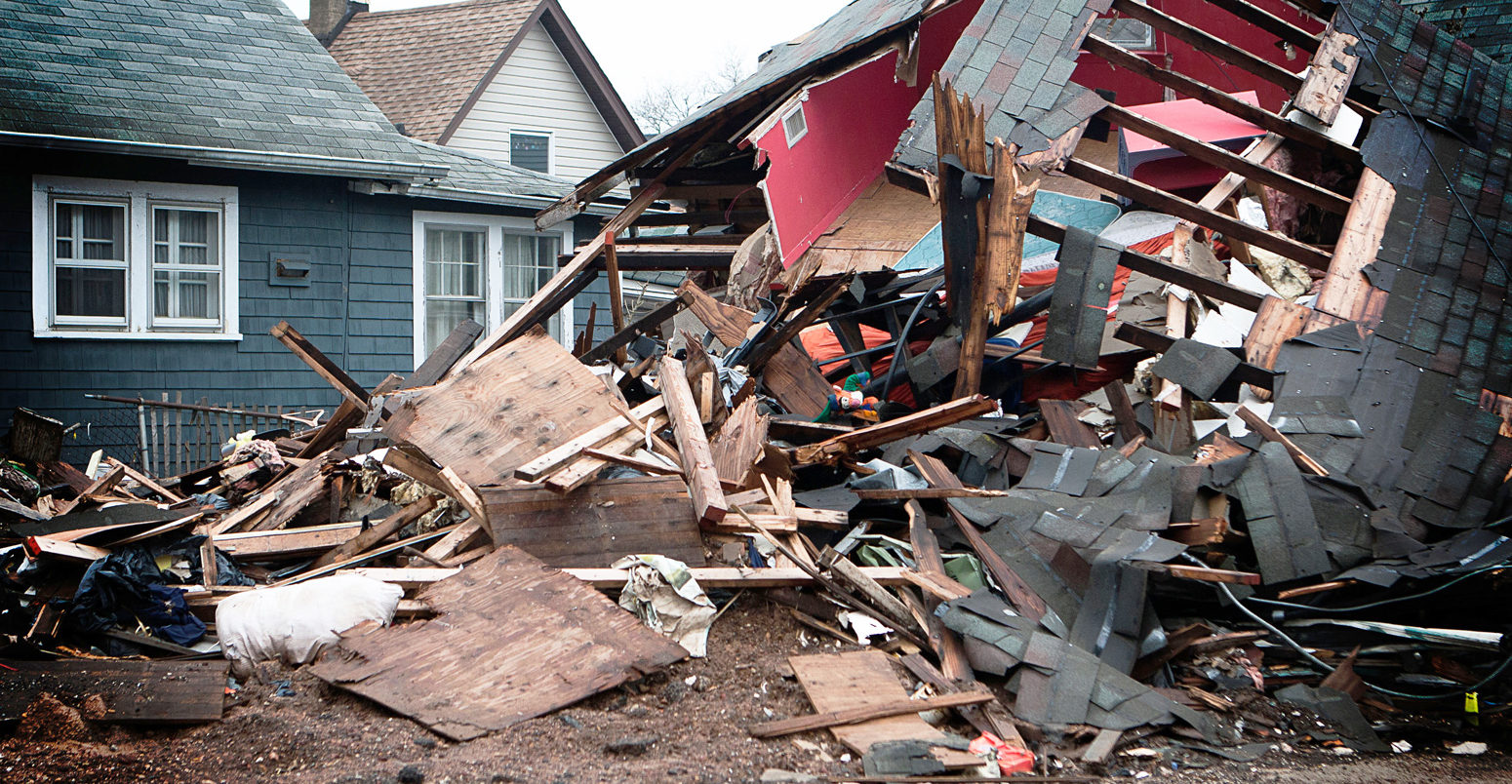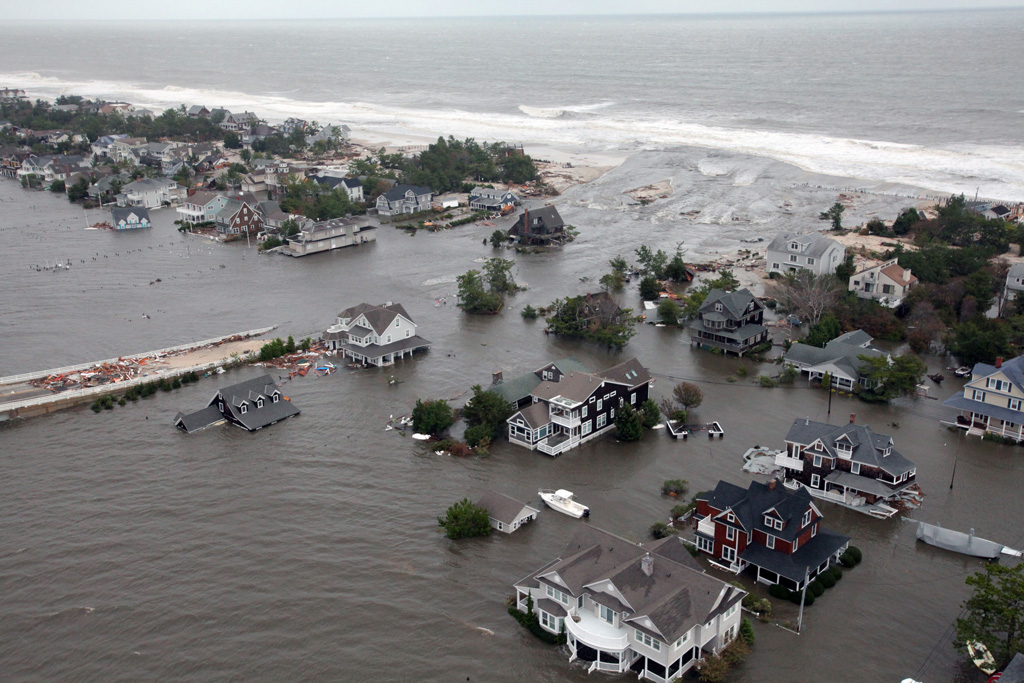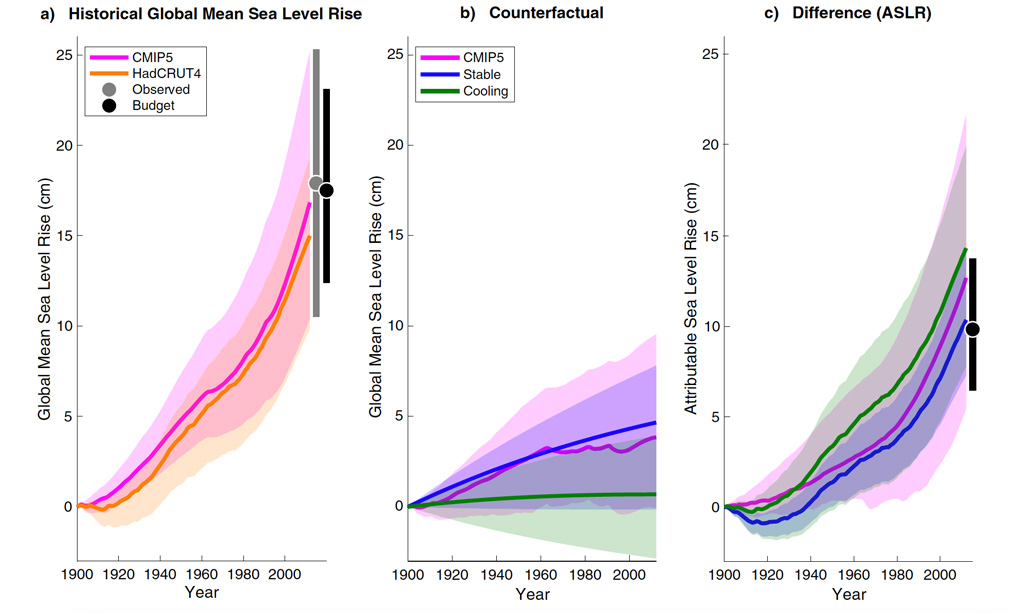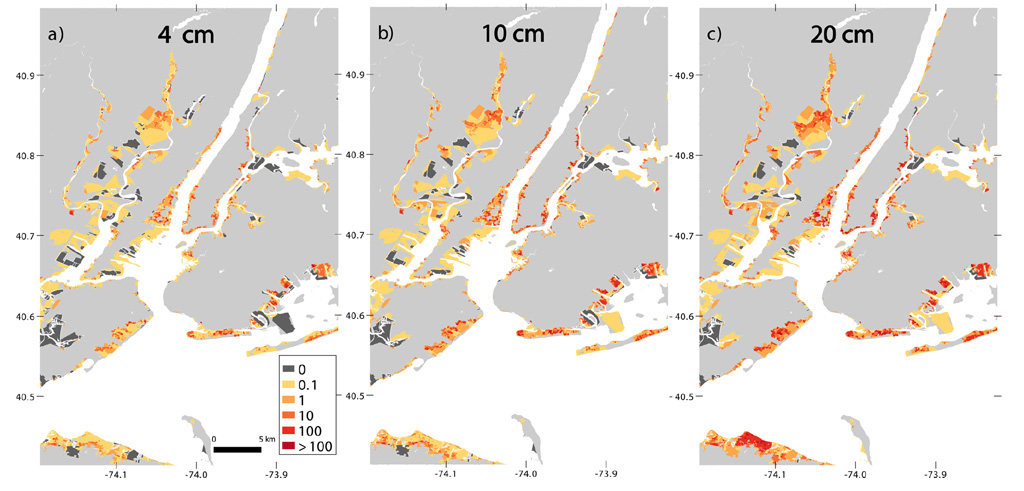
Hurricane Sandy caused an ‘extra $8bn’ damage due to human-caused sea level rise
Ayesha Tandon
05.18.21Ayesha Tandon
18.05.2021 | 4:00pmMore than $8bn of the damage caused by Hurricane Sandy in 2012 was due to the increase in sea levels caused by human-caused climate change, according to new research.
Hurricane Sandy hit the US east coast in October 2012, causing some $60bn of economic damage. The study finds that climate change caused around 10cm of coastal sea level rise in the area over the preceding century, which allowed the hurricane-driven storm surge to affect 71,000 additional people, adding $8bn in damages.
The study, published in Nature Communications, presents a “conservative” estimate of the damage caused by climate change, the lead author says, because it only considers the impact of climate change on sea level rise. The full extent of the influence of climate change on Hurricane Sandy could be larger, he adds.
A scientist who was not involved in the research tells Carbon Brief that the study is “unique” for focusing on sea level rise rather than frequency or rainfall amount, as attribution studies for storms typically do. He adds that the approach “brings in a new perspective” on attributing the influence of climate change on hurricanes.
The perfect storm
In 2012, a powerful “tropical-extratropical hybrid” storm called Hurricane Sandy hit the east coast of the US. Sandy was one of the most damaging hurricanes ever to make landfall in the US at the time. In the widespread media coverage of the event that followed, many called it a “superstorm”.
Sandy followed a “near-worst case storm track”, according to the study – turning unexpectedly towards New York city at the last minute. When it approached the coast, the hurricane drove a sudden rise in sea level, known as a “storm surge”, which sent water flooding into the New York metropolitan area.
The flood reached the highest level recorded in at least 300 years, according to experts. This is, in part, because the baseline sea level was already high when the hurricane hit – due to a combination of the local high tide and climate change-driven sea level rise, according to the new study.
Overall, the hurricane killed 53 people and caused an estimated $60bn in damages. Dr Benjamin Strauss, the CEO and chief scientist at Climate Central, is the lead author of the study. He tells Carbon Brief that during the hurricane, “all the elements lined up for almost the worst possible damage”.

Dr Friederike Otto – associate director of the Environmental Change Institute at the University of Oxford, who was not involved in the study – tells Carbon Brief that three aspects of tropical cyclones are key to how much damage they cause:
“There are three aspects of a tropical cyclone that cause damage – the wind speed, the rainfall associated with the cyclone and the storm surge…Of course, how much damage each of these three aspects cause is very different from cyclone to cyclone. For example, for [Hurricane] Harvey in 2017 and [Super Typhoon] Hagibis hitting Tokyo in 2019 it was primarily rain. For Sandy, much of the damage was from the storm surge.”
During Hurricane Sandy, the vast majority of economic damages were due to flooding, while only 0.01% of the damage came from high wind speeds. This makes Sandy “an ideal case study” for focusing on the damage from human-driven sea level rise, Strauss tells Carbon Brief.
However, this means the analysis is presenting “conservative, low-end” estimate of the impact of climate change on damages from Sandy, Strauss says:
“We didn’t look at the whole of Sandy, so we really see our estimate as a conservative, low-end estimate. We didn’t assess whether climate change made Sandy stronger or affected its path…But we isolated the effect of the higher starting sea level, and that’s just something we can stand on – it’s very rock solid bedrock for understanding the impact of climate change.”
Storm surges and sea levels
Global mean sea level rose by around 18cm since 1900. This means that the coastal floods caused by Sandy were starting from a higher baseline than they were a century ago.
The study uses two methods to determine how much of the global sea level rise over 1900-2012 was due to climate change – a detailed literature search of past research and a modelling approach.
For the modelling approach, the authors compare historical sea level rise to a hypothetical “counterfactual” world without climate change. In the plot below, the figure on the left shows observed sea level rise between 1900 and 2012 and the plot in the centre shows the counterfactual scenario.
The plot on the right shows the difference between the historical and counterfactual worlds, indicating how much historical sea level rise was driven by climate change.

The authors estimate that between 37% and 96% of the observed sea level rise was due to climate change, Dr Sönke Dangendorf – an assistant professor at Old Dominion University who was not involved in the study – tells Carbon Brief. He adds that this estimate is “consistent with earlier work using statistical and formal detection and attribution approaches”.
The authors use this value to estimate human-driven sea level rise around the east coast of the US by determining the global “fingerprint” of sea level rise, Strauss tells Carbon Brief:
“The change in the water surface level comes from several different components, and each component has a kind of global fingerprint to it – where it is causing more sea level rise in some places, and less in other places. Two of the three biggest components are melting glaciers and melting of Greenland, and for both of those there’s less sea level rise at New York than the global average.”
They then use hydrodynamic models to simulate Sandy’s flood under different “scenarios”, broadly representing the 5th, 50th and 95th percentiles of their estimates of the human impact on sea level rise. The maps below show three different flooding scenarios and the economic damages that they would cause.
The maps on the left, middle and right respectively show estimated damages for human-driven sea level rise of 4cm, 10cm and 20cm. Darker colours indicate greater economic damage, measured in millions of dollars.

As a central estimate, the authors find that 10.5cm of global sea level rise and 9.6cm of New York-specific sea level rise are due to climate change. Using this estimate, they find that 13% – or $8.1bn (£5.7bn) – of the damage inflicted by Hurricane Sandy was solely due to the extra flooding caused by climate change-driven sea level rise, and that the higher sea level allowed the floodwater to reach 71,000 additional people.
Strauss adds that damages do not increase linearly with sea level rise, meaning that “if you double depth you more than double damage for a lot of structure types”. To give an example, he compares the damages from Hurricane Sandy to those of Hurricane Irene the previous year:
“Sandy’s storm surge reached about 275cm above the high-tide line at the Battery in New York. And we’re talking about roughly 10cm of attributable sea level rise causing more than 10% of the economic damages. Hurricane Irene brought water to about 150cm above that high tide line and caused essentially zero economic damage. So it was really the last 125cm which mattered.”
‘A pioneering study’
Attribution studies of storms tend to focus on factors such as storm size, frequency and rainfall amount. However, this work represents something new, according to Dr Nikos Christidis from the UK Met Office, who was not involved in the research:
“The study is unique compared to other attribution analyses of hurricanes and tropical storms, as it focuses on the effect of sea level rise…Their approach brings in a new perspective on attribution of hurricanes and of this kind of hybrid storms, as this seems to be more suitable for the event under consideration and the attribution of associated damage.”
Dangendorf tells Carbon Brief that, to his knowledge, this study is “the first time such an approach to estimate the human imprint on Hurricane Sandy due to increasing sea levels,” adding that the study is “a very much needed contribution to the literature”.
Dangendorf says that the estimate of the climate change-driven contribution to global sea level rise is “very robust”, adding that the authors have “done a tremendous effort in using different approaches and accounting for the uncertainties”.
However, he adds that the attribution of New York-specific sea level rise is “a little less robust, as there haven’t been any formal detection and attribution studies on regional sea level change in the literature”, noting that it produces a “conservative” estimate.
Dr Matt Palmer from the UK Met Office, who was not involved in the study, tells Carbon Brief that the study is “pioneering”, as well as “an important step forward in improved understanding of the social and economic costs associated with anthropogenic sea level rise, which is needed to help inform climate policy and coastal management”.
However, he notes that there is still uncertainty in attributing sea level rise to human-driven climate change:
“We know that a substantial fraction of that sea level rise is directly related to greenhouse gas forcing of the climate system, although we cannot give a precise number.”
Prof Peter Stott – head of climate monitoring and attribution at the UK Met Office who was also not involved in the research – tells Carbon Brief that this is an “important study”, as it considers costs that are “often not fully taken account of in traditional economic assessments of the costs of climate change”.
However, he highlights that the high uncertainty in sea level attribution “translates directly into tens of billions of dollars worth of damage”. He also says it is “worth noting” that other analyses of storms have found higher costs from climate change – for example, a 2020 analysis of Hurricane Harvey, which estimates that $67bn of the total $90bn cost of that hurricane could be blamed on anthropogenic climate change.
As the planet warms and sea levels continue to rise, coastal floods are likely to get more severe. Christidis says that a good extension to the work would, therefore, be to “consider future risks under different scenarios”.
Strauss, B. H et al. (2021) Economic damages from Hurricane Sandy attributable to sea level rise caused by anthropogenic climate change, Nature Communications, doi: 10.1038/s41467-021-22838-1
-
Hurricane Sandy caused an ‘extra $8bn’ damage due to human-caused sea level rise
-
Human-driven sea level rise caused Hurricane Sandy to flood ‘36,000 additional homes’

